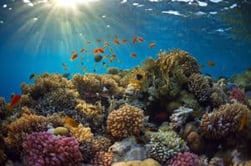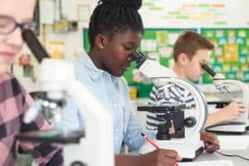Elements and Compounds Inquiry Lab
Middle School Inquiry Lab on Elements and Compounds
In this lab students will identify compounds, identify elements within the compounds based on the chemical formula, and observe them in chemical reactions.
Each inquiry lab will contain an essential question that will drive the lesson and make students think. For this lesson, the essential question is:
- Why are elements and compounds represented differently in chemistry?
BACKGROUND INFORMATION AND MATERIALS LIST:
Students will begin the lab by reading the essential question and background information. This can be done individually, as lab groups, or as a whole class. If you consider lab groups, you also might include some type of whole class formative checks before digging into the lab.


Materials List:
- elements card page
- zipper sandwich bags
- scissors
- personal safety equipment (goggles, gloves)
- stirring rod
- Sodium Bicarbonate (baking soda)
- Calcium Chloride
- Ammonium Chloride
- vinegar
- thermometer
- water
- 1 250 mL beaker
- 1 teaspoon
PROCEDURE:
Students will have to cut out element cards and sort them to better prepare for their use later on in the lab activity. Students will have to make qualitative descriptions of the lab materials and record their observations on their lab sheet. Students will then complete three lab activities. They will observe and record the outcomes of mixing the three solid substances with a liquid. Each activity will ask students if they see a production of gas or a change in temperature and record their findings on their lab sheet.
Using the element cards, students will fill in their template showing the elements involved in each substance and their reactions. This will allow students to see whether or not a chemical change has taken place.
CHECK FOR UNDERSTANDING:
At this point in the lab, students will be checked for understanding by answering questions about their findings. Here are a few that come with the lab:
- Which substance, when combined with water, creates a compound and an element?
- Which substance, when combined with water, creates other compounds?
- Which substance, when combined with water, breaks the original compound into the elements it is made of?
CONCLUSION
Students will go back to the essential question and write a CER (Claim, Evidence, Reasoning) to conclude the lab. Once completed, students will reflect back on their learning by answering the following questions:
- What is the difference between an element and a compound?
- Based on what you know about elements and compounds, why did the compounds look different after adding water to them?
MODIFIED AND INDEPENDENT INQUIRY VERSIONS
All of the Kesler Science inquiry labs come with three different modification levels. Each lab is differentiated using the icons below.
STANDARDS ALIGNMENT
TEKS: 6.5A – Know that an element is a pure substance represented by a chemical symbol and a compound is a pure substance represented by a chemical formula.

Download Over $100 in FREE Resources
For Middle School Science
Simply create a login below and gain immediate access to a selection of our Kesler Science product line worth $100 - for FREE. There's a full version of every product type! You'll also join tens of thousands of middle school science teachers who receive timely tips and strategies straight to their inbox.





